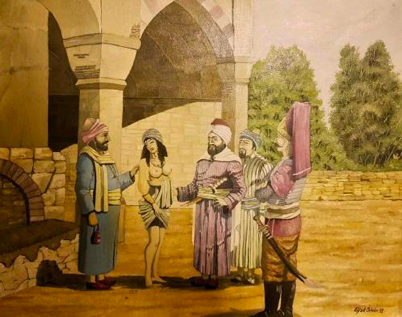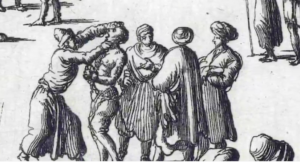Slavery: How the Ottoman Empire took it to the next level


In a previous article, we explored how Islamic scripture condoned slavery. You can read this article by clicking the link here:
Slavery – How it survived and flourished after the 7th century
Slavery in Islamic law is not based on race or ethnicity. However, while there was no legal distinction between white European and black African slaves, in some Muslim societies they were employed in different roles: for example, the Ottoman Empire made white slaves (From Russia and other states) serve as soldiers and government officials, while black slaves were placed as guards at palaces and the harems of elite families.
The subject of slavery in the Ottoman Empire is not a topic widely discussed amongst the literary circles. The Muslims choose to completely oversee these large scale harrowing atrocities on a captive people. Professor George Junne of the University of Colorado has written a book on the subject, in which he talks about the key role that eunuchs played in the Ottoman state. He describes how the Ottomans bought the slaves after checking their value in terms of performing arts as well as their capacity to run businesses etc. The slaves would be priced according to their skills and will be assigned tasks as per their calibre.
In his book, Junne describes how a black slave would be completely separated from family and friends. The Ottoman practice of eunuch-making, and the institutionalization of it, was one of the many customs they used to control Kuffar. The main difference between the white eunuchs and the black eunuchs is, that with the white eunuchs, they just took out their testicles. With the black eunuchs, they were completely “shaved,” meaning that everything came off. The white eunuchs were sourced (bought and abducted) by the Ottomans bought and from Christians and Jews. The Black slaves who were later turned into Eunuchs were simply abducted. Afterward, they ended up either in the Sultan’s Harem as guards, or in Istanbul, where there were a lot of very rich men who had their own personal harems. This went on throughout the Ottoman Empire. The advent of Kemal Atatürk put got rid of things like the harems and the eunuch system as Turkey tried to become more European.
Scholars trying to be balanced have argued that religious scriptures contain a number of verses aimed at regulating slavery and mitigating its negative impact. They state that the Quran prescribes kindness towards slaves, that they are considered morally equal to free persons, perhaps with a lower legal standing, and that Quran aimed to gradually phase out slavery altogether. But it did not make slavery Haram, like it states about the consumption of pork. According to Dr. Shabbir Ally, a Muslim scholar, the Muslims did not follow the instructions of Quran and were therefore not able to abolish Slavery from their midst until the Europeans made it illegal in some countries. However, the matter of slavery is left to interpretation in the scriptures and, as many proselytising Muslims would want us to believe, should be read about keeping in mind the background (Syaq o Sabaaq). Those who cannot make logical sense of this practice but still are adamant defenders of the scripture believe that since there is a Hadith on correcting what is wrong, which says that there should be no harm to anyone, therefore the followers of Quran were the ones who were given open initiation to stop slavery. However, even they cannot justify the order for slave girls to remain only partially dressed when in public, to differentiate between a slave and a free woman. According to the Hanafi School of thought, during the early days of Islam, it was already proscribed that a slave girl was to hide her body “from navel to knees”.
The Ottoman Empire which wanted to spread far and wide, also had a notorious hubble of pirate ships, which would go to European countries, and plunder their lands. In the process, they will also bring with them a large number of European slaves. One particularly harrowing narration of how the Ottoman pirates reached Iceland and took people to the slave market in 1627, describes that during one siege, the pirates captured people from their homes, markets and crevices of mountains where they were hiding with their families. In this process, the pirates set on fire the churches and killed those who were of no need to them, including the older Pastors. Those seen fit to be traded were taken aboard the pirate ship and soon it set sail away from Iceland. According to the narrator, there was one pirate who was very particular about washing himself every day, even had other people wash his body. One woman on the ship who was name The Honest Helen, told the narrator that very person had killed her husband. The ship came to a stop at Algiers and all the Ice Landers were taken to the slave market, where they found numerous other people also being put on sale.

The narrator further talks about a pretty girl who was bought for 1000 Dinar and her Master too her to Jerusalem to sell her for profit to a Christian man, becuase Christians could not have sex with Turkish (Muslim) women.
The Ottoman Sultans made great use of the unclarity in Quran about slavery, to serve their own purposes. According to the book called “The Legacy of Arab-Islam In Africa”, the British Consul General in Morroco wrote a letter to the Sultan Abul Hamid II askig him if he had taken any measured to stop slavery or the slave trade. The Sultan replied that all sects of Islam agree there is nothing mention in the Quran, and it has been the norm since the time of Adam, therefore he plans to do nothing about it. This response of the Sultan encapsulates the justification of around 1300 years of slavery post the arrival of Islam.
References:
The Travels of Reverend Olafur Egilsson: The Story of the Barbary Corsair Raid on Iceland in 1627. by Olafur Egilsson
An interview of Dr. Shabbir Ally
The Legacy of Arab-Islam In Africa by Azumah John Alembillah & Race and Slavery in the Middle East by Bernard Lewis
DISCLAIMER: The author is solely responsible for the views expressed in this article. The author carries the responsibility for citing and/or licensing of images utilized within the text.
